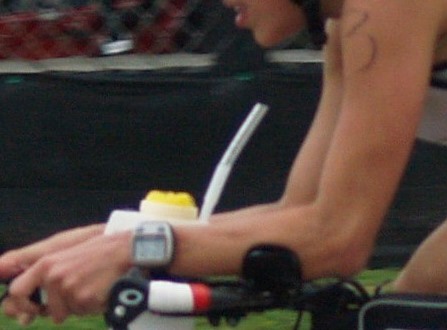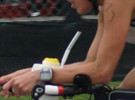How to Increase Comfort in the Aerobars for Triathlon
Posted by Matt Russ on 2nd May 2018
 The aerobar or aero position was not designed for comfort, is was designed to reduce drag which it does a great job of. But it is by no means natural to the human body and many people have a hard time acclimating to it. If you find yourself sitting up to get relief then you are mitigating a lot of the gains of the aero position. There are some things you can do to improve comfort, sometimes drastically.
The aerobar or aero position was not designed for comfort, is was designed to reduce drag which it does a great job of. But it is by no means natural to the human body and many people have a hard time acclimating to it. If you find yourself sitting up to get relief then you are mitigating a lot of the gains of the aero position. There are some things you can do to improve comfort, sometimes drastically.
- Get properly fitted to begin with. I have had triathletes come in for a fitting having suffered months or even years of discomfort that could have been solved with just a few simple changes. If you are new to the aero position or coming off a road bike it is important not to get too aggressive (low torso angle). I like to take athletes down in stages letting their muscles stretch and get acclimated over time. Fitting the aero position can be tricky and there are a lot of subtleties to it. It is best not to go it alone but use a fitter that you can communicate your goals and history with. Some fitters tend to the fit the athlete to the fit; not the other way around.
- Adjust your upper arm position. The upper arm or humerus bone should support the torso like a column supports a roof. If the humerus is at too acute of an angle the muscles of the upper back have to work harder to support the torso. This is exacerbated in a triathlon where the large trapezius muscles are already fatigued from the swim. A good position should have the outer condyle of the elbow under or just forward of the shoulder joint. Do not make the mistake of moving your cockpit forward (like Superman) to get lower. This should be accomplished by adjusting the height of the bars.
- Change your width. There is a tendency to bring the arms close together assuming this creates a lower drag profile, but this is not necessarily the case. If the arms are well inside the hips the air that would have been hitting them now goes to the hips. The only way to determine these things is with small adjustments in a wind tunnel which for the vast majority is not practical or affordable. If you are a long course triathlete having a closed arm position is too fatiguing. The muscles of the upper back are over-stretched and taught. Opening that position up even a few millimeters on each side can make a big difference. Note that moving the pads wider will not change the arm width, it will just put the arm at a more acute angle to the shifters.
- Check your pads/adjust your armrests. Aerobar pads wear out but for some reasons athletes hesitate to change them. There have been big improvements in armrest designs providing more adjustability and comfort. Some pads even come in different thicknesses which makes sense for a heavier rider. Many of the newer armrests can be retrofitted to older aerobars upgrading your comfort without breaking your bank. If you find your pads are really thin, especially towards the back of the pad, it is time to replace them. The armrests should be positioned just forward of the bony part of the elbow and on the forearm. If the armrests are two far forward they are no longer supporting the upper body like the aforementioned column. The armrests should be angle to match the angle of the lower arm. Feel free to play around with this to find the position that feels the best.
- Set your cockpit to neutral. A neutral position is one in which the body naturally falls into and is less fatiguing. Sitting up put your arms in the aero position then lower your torso onto the bars. If you have to drastically alter your position to get in the aerobars you are out of neutral. The cockpit should be fitted to where the body naturally wants to go. This includes the rotation of the bars.
- Put the shifters in your hands. You should not have to alter your position to shift, the shifters should naturally fit into the hands without extending. If you are moving your arms towards the shifters to shift they are too far away. This uses a lot of excess energy and movement and is less safe.
- Change your bike's aerobars. Many of the older aerobars had little or poor adjustability. The more adjustable the bar is the better. Many bike brands made poor (cheap) choices in OEM bars that lacked adjustability. You should be able to alter the fore/aft of the bars, rotation of the bars, height of the pads, rotation of the pads, and the bars and pads should be independently adjustable. If your aerobar lacks these adjustments a change may be warranted.
- Change your extensions. Aerobar extensions come in a wide variety of shapes. Some are designed for a more leveraged position for short course triathlon or time trialing in which the riders pulls up on the bars to improve power. These are generally straight or "s" bend extensions. Then there are a variety of extensions that are designed to fit more comfortably in the hand in a relaxed position, and then there are some inbetween. For long course triathletes I generally avoid the "s" bend extension as it causes more wrist and forearm fatigue over time and the leverage is not needed.
A good place to start is by setting a neutral position and then making smaller adjustments to test comfort. Many of these adjustments are ergonomic in nature meaning they won't necessarily affect power output. Note that lowering your position without properly adjusting the seat lowers the torso onto the knees closing the hip angle. This can comfort AND power. In order to go lower you must also go forward with the seat and cockpit to maintain hip angle, and adjust the seat height, and when you get frustrated trying to go it alone with all these factors get a professional fit. A more comfortable position is a faster and safer position over time. Holding an uncomfortable position causes fatigue and utilizes energy that could be going to the pedals.
Matt Russ is a full time professional coach with over two decades of experience working with athletes up to the professional level. His athletes have achieved numerous regional, national, and international titles under his direction. Matt has achieved the highest level of licensing by both USA Triathlon and USA Cycling, and is a licensed USA Track and Field Coach. His accomplishments include being named "Team USA" Coach by USA Triathlon. Matt is Head Coach and owner of The Sport Factory, a USA Triathlon Certified Performance Center located in Roswell, Georgia. Visit www.sportfactory.com for more information or email him at coachmatt@thesportfactory.com


